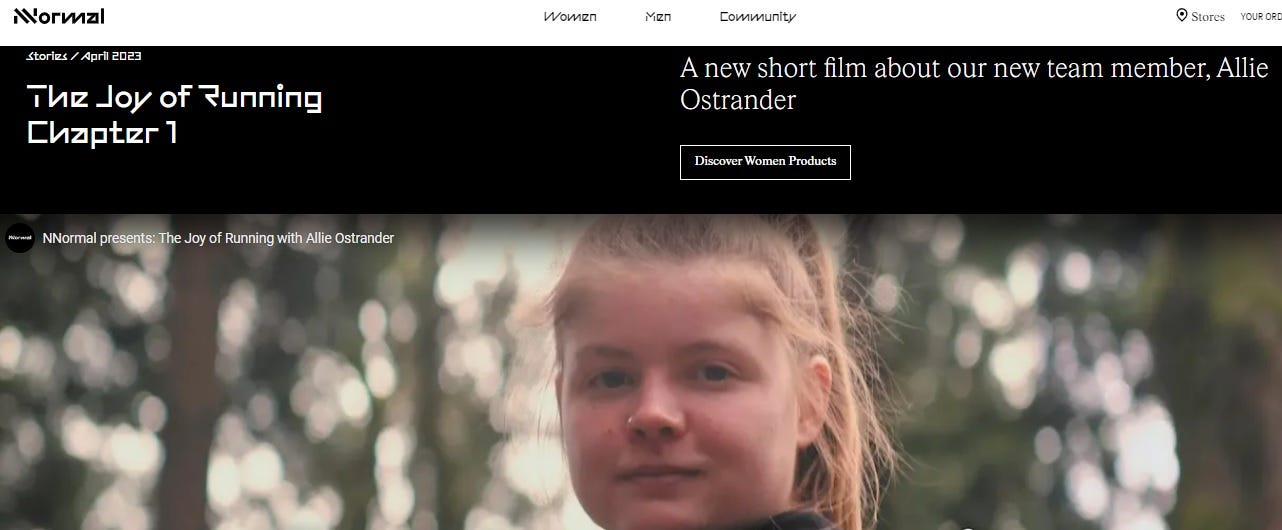Allie Ostrander's four-month ban for a masking agent detected in an OOC test was levied soon after she signed with Kilian Jornet's gear company NNormal
No wonder demoralized trail runners of privilege worship this guy. And we need better masking agents for masking agents
Flotrack reported on Friday that the U.S. Antidoping Agency (USADA) had disclosed the about-to-end four-month suspension of distance runner Allie Ostrander. With the ban in its final 72 or so hours, USADA announced that Ostrander had accepted that ban. That seems nice of her; I wonder how she’ll handle the layoff, which took effect on April 28. Inspired by her example, I might decide to accept at some point being a Sagittarius, even though I don’t act like one and as notoriously stubborn as we can be about conforming to type.
Ostrander, who has flitted for years between recording outstanding performances and taking time off from racing to publicly process her florid if mundane neuroses, was suspended for using a derivative of a prohibited diuretic called spironolactone. Now in its sixty-fourth year of clinical use in the United States, this drug possesses the handy attribute of not leading to significant potassium-wasting, which furosemide (Lasix) notoriously does. Diuretics that cause both sodium and potassium loss along with water loss are far more likely to kill you via cardiac arrest than a compound like spironolactone is.
Spironolactone promotes vigorous salt and water wasting by inhibiting the action of the mineralocorticoid aldosterone. (The renin-angiotensin-aldosterone hormonal “axis” is the main reason you adapt to heat in the summertime; aldosterone activity promotes plasma-volume expansion through sodium-ion retention at the kidney.)
This is not something a distance runner would typically desire, but diuretics have been used for a long time as “masking agents”—that is, substances that may not confer a direct athletic benefit, but help athletes beat doping-control tests. Spironolactone has been banned in international swimming since at least 2001.
Ostrander’s positive test resulted from a sample submitted on March 30 in an out-of-competition (OOC) test, the sport’s version of random screening. This was a little over a month after Ostrander signed with NNormal, a company owned by Kilian Jornet. From a February 24 Canadian Running piece:
American steeplechaser Allie Ostrander announced on Wednesday that she has signed with Kilian Jornet‘s new outdoor sports brand, NNormal. The partnership comes after Ostrander took a one-year break from professional running. In addition to the news of her new sponsorship, it was announced that she is transitioning from track to trail running in the coming season.
While Ostrander provided evidence of having a prescription for an anti-acne medication containing the substance, she didn’t apply for a therapeutic use exemption (TUE). While Ostrander may well not have a cheating bone in her body, as Wisconsin dermatologist Gabriela Maloney points out, this was her suspension to prevent:
Dermatologists need to be aware of this potential career changing consequence for their athlete patients. It’s also important to encourage patient athletes to educate themselves on the specific regulations and consult with their respective sports federations or anti-doping agencies to ensure compliance and prevent potential ban from competitions.
Based on his public persona, the people who admire him, and the specific things he’s done in the disciplines in which he competes, I trust Kilian Jornet about as much as I trust the U.S. Centers for Disease Control. I have pegged him as a probable slimeball, in fact, ever since questions persisted about the legitimacy of his reaching the summit of Mount Everest twice in one 2017 week without using supplemental oxygen.
I’m not suggesting Jornet had anything to do with any performance-enhancing substances Ostrander used, if she used anything. But if anyone wonders why I seem to default to suspecting the most accomplished trail runners of being dopers, it’s because of stories like these. For all of Ostrander’s often heart-wrenching problems, she managed to stay out of official trouble until she decided to switch solely to trails and became connected to a suspicious figure—one admired by proudly unethical clowns like the Roches of the coaching swindle “Some Work, All Play” and their most annoying known athlete, the Barry Bonds-headed boasting-factory Grayson Murphy.
NNormal named the short introductory film about Ostrander “The Joy of Running.” I honestly worry—honestly—that Allie Ostrander not only won’t be able to find much joy in running if she doesn’t just detach from the online clamor completely and indefinitely, but she might not even be alive in ten years. And every time I see another photo of Molly Seidel, I worry about the same thing. I’m not the only observer whose thinking trends this way, and the common theme among us is both having been around long enough to understand what kinds of situations tend be associated with what sort of outcomes and being able to empathize with the inner roiling of the main players—who always seem to need far tinier circles of friends than their present circumstances easily permit.
No one has ever been condemned to moral failure by anyone with a brain for failing a drug test even when they admit they were cheating. As much as I sling arrows at the lowbrow deceits used by Nike et al. to disguise the nature of the game, well, this is the nature of the game. I understand that pressures are real and that normal, decent people can and do respond to strong incentives to do things they would rather not.
Being in the public eye is really not most distance runners’ thing anyway, especially women, and I would rather know that someone is healing and thriving off the Internet grid than see them remain on it and suffer for the simple fact of the bright exposure.



